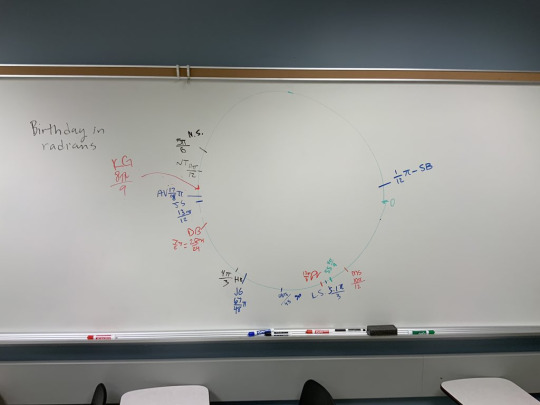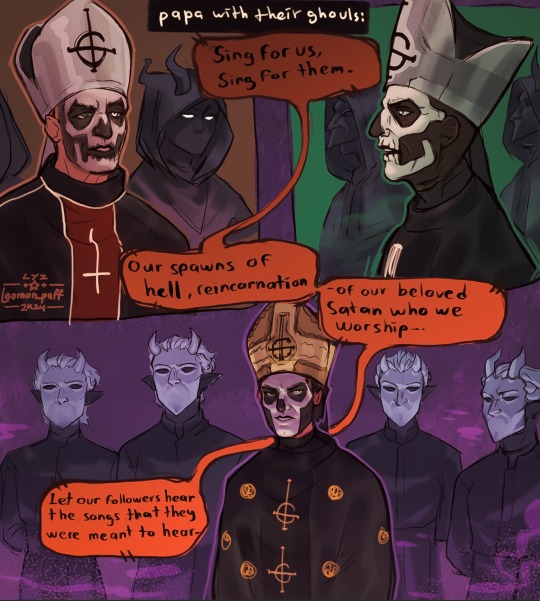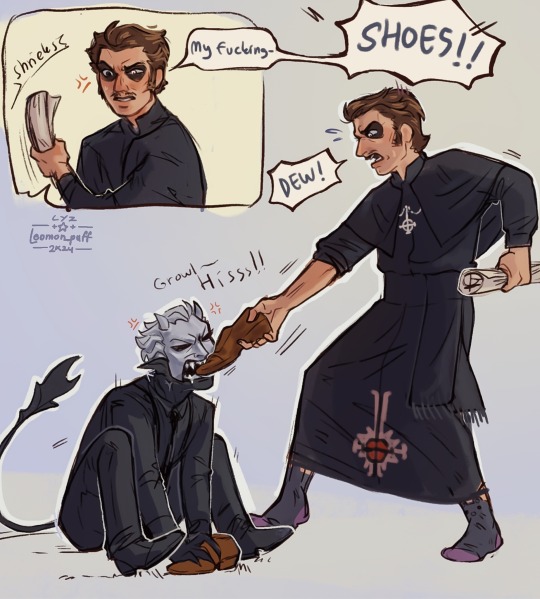#cardinality
Text
have anyone ever think about the cardinality of the infinity train? like, is the infinity train infinite as in the integers or is it infinite as in the real numbers?
9 notes
·
View notes
Text
finished huntinality 3! whew what a great time
our super small super casual team "huh?" consists of me, @nivrad00, and @lunacyecho. we had fun!
i'll do a writeup of at least one puzzle from it sometime - there were many great moments in there for me. for now here's a screenshot of our spreadsheet's landing page (contains hunt spoilers)

4 notes
·
View notes
Text

Honestly I felt so vindicated knowing this. Thanks, gacha game~
8 notes
·
View notes
Text

Counting, Counting
Mathober Day 8: Counting
We talk a lot with preservice teachers about the importance of counting. And with each new kind of number! Low counting numbers, double digit, higher place value, fractions, decimals, negatives, and, bending the definition a bit, imaginary and matrices. We need to connect number with quantity before learners have cardinality.
To some extent, we did that today with radians!

2 notes
·
View notes
Text
First post!! I wanted to show you how deep a rabbit hole you can dig with a very simple concept like, "What does 'four' mean?"
I have a number line.

So, I'd like you to imagine that you've sat down across from me on your first day in class, and I put some kind of math worksheet with this number line on it that gives you a very simple-sounding task: "Circle four."
If you are like nearly every one of the older students I've had, you'll circle the number 4 on the line. And I'd say something like, "That is a perfectly reasonable response to this request. There is nothing wrong with what you've done. But aren't you suspicious about how simple this question sounds? Did you see that there was a twist coming?"
On a number line, the place where we've written 4 is not actually the value 4. It is more like the position 4; we would call this the ordinal number (a number used to track the positional order of things; another example of an ordinal number is the word "fourth," which tells you that there are three other things before that one).
So, if you just circled the number 4, you definitely circled the position, but the thing you circled isn't worth 4. If you were going to circle the thing that has the value (or cardinality, since we're counting individual objects) of 4, it would look something more like this:

This is because in order to have the value of 4, you need everything that came before it! Imagine counting out candy while your kid sister steals and eats the candies you counted already. When you get to your final number, that number is not how many candies you have, but rather how many you counted cuz your sister's got 'em all! For the value of your candies to stay the same, you need all of them to be there!
"Four" could also look, less straightforwardly, like this:

The distance from the start of the circle to the end is four; and since we're circling the line, the length of the line that is circled is four. If we imagine the circle starts (from the left) at the position of 2.3, it would have to end at the position (from the right) 6.3. If we find the difference of the numbers at these positions, we would be doing the equation 6.3 - 2.3 = 4.
A quick summary:
The position of a number is shown with an ordinal number.
The actual physical quantity of the individual items is shown with a cardinal number, which we more typically call the value.
We can find a value inside the ordinals by finding the distance between any two ordinals, via subtraction.
Okay... But notice we've used two words here that seem to imply the same thing: difference and distance. Let's clear this up real quick:
Difference is the result of subtraction. Generally, if we want to find the difference between two things, we subtract the first thing from the second thing:
second - first = difference
But that's not a rule, so much as a norm. In reality, if you wanted to find the difference of two numbers, the person asking had best be very clear which way they want you to do it, because if you reverse this you will get the negative of the result above!
For example, if you were asked to find the difference between 6 and 15, you would do 15 - 6 = 9. But if it's not clear and you instead did 6 - 15, you get -9.
If, however, someone wanted to know how far apart these two numbers are, they would not be asking the difference but rather the distance between these numbers. The result would therefore be the absolute value of either one of these subtractions:
|15 - 6| = |9| = 9,
|6 - 15| = |-9| = 9
Same result!
This is in actuality the real use of absolute values. Absolute value is typically shown as "the distance from zero," which is kind of true? But it's really for finding distances of any kind -- in fact, it's later used to mean exactly that when you get into complex algebra (that is, algebra with imaginary numbers) and linear algebra (matrices and vectors).
But that's for later.
#math#mathematics#math help#math tricks#math teaching#arithmetic#algebra#cardinality#ordinals#subtraction#absolute value#numbers
2 notes
·
View notes
Text
Going to try to explain "there are just as many real numbers between 0 and 1 as there are between 1 and ∞" in a way that makes sense to people who don't have much of a math background or just forget everything they used to know.
What we need to do is take these two sets (0,1) and (1,∞) and show that they are the same size. Now if these sets had a finite number of things in them, that would be easy, because you could just count them. But they don't have a finite number of things, so we can't count them. Instead what we do is pair up the numbers between the sets. If we can pair numbers up in a way that a) every pair has one number from each set, b) every number is only in one pair, and c) there are no numbers from either set left out, then the sets are the same size.
We can use this method with finite sets as well, so I'll show you an example of that first.
Set A = (1, 2, 3, 4)
Set B = (10, 20, 30, 40)
So in this case, we could make the following pairs: 1 & 10, 2 & 20, 3 & 30, and 4 & 40. Every pair has a number from each set, each number only shows up in one pair, and there are no numbers left over from either set, so we know that set A and B are the same size (since these are finite, we can also just count them to see that there are 4 numbers in each set, but that's not the point).
Now, we could have picked the pairs any way we wanted, but in this particular case we actually used a pattern to choose the pairs. Everything in set B is a multiple by 10 of something from set A, and that's how they're paired up - each pair is a number from set A and that same number multiplied by 10, which also happens to be a number in set B. That means that instead of writing out all 4 pairs like I did above, I could just say that all of the pairs will look like δ & δ*10 (assuming δ is one of the numbers in set A), and that covers everything. Excuse my use of the Greek letter δ; it's pretty commonplace to use Greek letters in math, and I couldn't pass up the opportunity to actually use delta in this post since, you know, it's in my url and all.
So anyway, that's what we need to do to show that (0,1) and (1,∞) are the same size, since it's impossible to write down every single pair. And it's actually pretty easy to do. If δ is a number in (1,∞), then the pair it belongs to is 1/δ & δ (similarly, if δ is in (0,1) then the pair is δ & 1/δ - this is a particularly nice way to pair them because 1/(1/δ) = δ, so the pattern is the same regardless of what set you start with a number from).
This includes all of the numbers from both sets exactly once. Here are some examples:
68 is a number in (1,∞). It gets paired with 1/68, which is in (0,1)
1000 is a number in (1,∞). It gets paired with 0.001, which is in (0,1)
2/5 is a number in (0,1). It gets paired with 5/2, which is in (1,∞)
Those examples all work, but how do I know that the three conditions I laid out earlier are ALWAYS true? Well, let's look at each of them.
a) every pair has one number from each set
So we know that our pair is always δ & 1/δ. If δ is a number in (1,∞), then 1/δ has to be less than 1 (because the numerator is smaller than the denominator) and greater than 0 (because δ is a positive number). And the same is true for δ in (0,1); 1/δ will always be larger than 1 (because the numerator is larger than the denominator).
b) every number is only in one pair
δ is always paired with 1/δ. Each of these are unique values. You can't get 1/δ from dividing 1 by anything other than δ, so this is the only pair it belongs to.
c) there are no numbers from either set left out
This is the trickiest one I think, but it's true. It's easy to think that because (1,∞) looks so much bigger than (0,1), there must be something left out, but there's not. The easiest way to show this is by assuming it's NOT true, and then showing how that can't happen. So let's suppose there's some number in (1,∞) that gets missed. I'm going to call it ε. If it gets missed then that means 1/ε ISN'T in (0,1). But if ε is in (1,∞), then 1/ε has to be less than 1 (because ε > 1) and greater than 0 (because ε is positive), so 1/ε actually IS in (0,1). Which means ε didn't get missed, it has a pair. And you can make the same argument if you assume a number is left out from (0,1). So no numbers have been left out.
I hope this makes some sense; I've tried to explain it in a way that isn't too complicated, but I know that infinity is weird and math is complicated so I won't be offended if it doesn't make sense. But I'm also happy to try to explain some more if anyone is interested!
Tagged @crissmastrees-and-candyklaines @blog-carmex @itstruthtime since you're the ones this has come up with, but happy to open the conversation to anyone else who might be curious!
#mine#math#set theory#cardinality#the blogger formerly known as#blurglesmurfklaine#blog-carmex#itstruthtime
6 notes
·
View notes
Text
can anyone tell me why i enter the grocery store a normal person and emerge as some sort of vile ravening monster
#was trying to leave the self-checkout and someone was standing in front of the exit gate looking at their phone and blocking the whole lane#the malignant influence of the grocery store transformed this from a minor inconvenience to a cardinal crime#i was ready to leap at them like a coyote and tear them to shreds#be shh now
74K notes
·
View notes
Text
Headcanon where after so many arguments between the batkids and Bruce over his paranoia and complete disregard for his kids privacy, the entire family had compromised with (in the healthiest way possible) downloading life360 on their phones and that's how they all keep track of each other.
Now Bruce knew that this is mostly for his benefit and is supposed to be a healthy alternative for his unhealthy paranoia and helicopter parenting, but what he wasn't expecting was for his kids to start keeping track of him.
He's putting gas in his car and Dick calls him because apparently Dick has been watching him drive around on the app? And Bruce is currently at a gas station thats right around the corner from a Taco Bell and now Dick wants him to get food for everyone since he's already there.
He's driving home from a meeting and Steph calls him because her and Duke were shopping in the area and wants to know if he can pick them up, when he asks how she knew he was on the same street, he gets a "Oh I just like to stalk everyone on the app for funsies." as an answer.
Jason calls him and he can barely get out a hello before Jason cuts him off, "Bruce why the fuck is your phone battery on 5%, charge your damn phone" which completely stuns him because why does he know that. He clears his throat before answering. "Jason, what?"
"Everyone can see each others phone batteries on '360, now charge your phone." Is all he gets before Jason hangs up on him.
#I have more ideas in my head#but I didn't want to make the post too long#might repost later#might write a small fanfic off of this#I actually don't have life360 but my friend does and I'm basing this off of how she interacts with her mom#batfamily#batfam#headcanon#dick grayson#nightwing#bruce wayne#batman#jason todd#red hood#tim drake#red robin#cardinal tim drake#stephanie brown#spoiler
10K notes
·
View notes
Text
Huntinality III: Hunts Upon a Time
Link's Final Stand
- Identified the sell prices as indicators of word length for the rebus solutions (rupee number divided by 100) and attack power as the numbers for indexing
- Identified rebuses for CAPRICE, DISCOVERED, EARNEST, GENERATING, TENANTS, and THINKING
- Identified mechanic where the solutions to the rebuses were the ways to defeat the various Ganondorf forms (as their sort-of opposites)
Into the Woods [Meta]
- Identified "SEE THE KING" as a possible candidate for an unsolved feeder puzzle and caught an oversight where "SELL THE COW" had two possible slots where it could fit and had been inserted into the wrong one
Missing Members
- Identified the extraction method: use ROYGBIV ordering for the colors associated with each substring and read the first letters of the substrings
Around the World
- Identified 8/12 of the video games
- Identified 30/45 of the locations, characters, items, and objectives clued
- Figured out the ordering method for extraction: order by video game release year
- Figured out the question being asked, clued by the extracted phrase GIANT SPARROW, was WHAT REMAINS OF EDITH FINCH, and the answer and final puzzle answer was FINCH
Weaving
- Figured out the clues "Process which breaks on reordering" and "In rock is ore" were a pair and had to be interwoven together to produce the cryptic crossword clue "PROCESS IN WHICH ROCK BREAKS IS ON ORE REORDERING" and the answer "EROSION"
Creatures [Meta]
- Figured out that each letter of the alphabet only appeared once in the first halves of the clues, as indicated by the flavor text, which was an altered version of "The quick brown fox jumped over the lazy dog"
- Figured out that the answers to the clues needed to be paired with the feeders to produce the name of a specific animal species, e.g.
+ (Animal/coloration descriptor) ZEBRA + FINCH
+ (Autonomous prefecture) CHUXIONG + FIRE-BELLIED NEWT
- Figured out the answer to the clue "Headgear descriptor" was CASQUED to pair with the feeder OROPENDOLA
What's Next?
- Solo-solved, including figuring out that the solutions to the rebuses all appeared in the lyrics to the Billy Joel song "We Didn't Start the Fire" and indexing into the item that occurs next in the list in the song
Are You The One?
- Figured out the clues indicated wordplay that revealed which letters each person wanted to see in their perfect match's name, including:
+ Match who appreciates a good kayak or racecar and loves their mom is AVA
+ Someone who can drive them around is GIOVANNI
+ Partner who follows a straight edge lifestyle is HEATH
+ Match who will sit down and rest after adding a man to their life is OTTO
+ Partner who knows all the right angles for pictures is ELLIE
How Many Reps?
- For the Chinese Zodiac subpuzzle, figured out that the clues "VASTLY POWERFUL," "VEER ONTO A TANGENT," and "DON'T RUSH" belonged to this category with the respective answers of "STRONG AS AN OX," "DOWN A RABBIT HOLE," and "HOLD YOUR HORSES"
- Also figured out the extraction method for this subpuzzle: indexing the place of each animal in the Chinese Zodiac into each associated clue phrase to get WALRUSSIA
Candies and Stories
- Identified the altered fairy tale titles "THE FOG AND THE SPARROW," "THE RUBBER BRIDEGROOM," and "THE WOLF AND THE KITS"
Keep Out
- Determinedly (teammates spectated me continuing to solve this puzzle even after the last meta had been solved) solo-solved (except for places where my math was corrected by teammates because sleep deprivation caused me to forget everything I knew about PEMDAS), including:
+ Creating a comprehensive map of the text adventure game in Google Sheets
+ Identifying the chemical compounds used as ingredients
+ Figuring out the two ingredients needed for each colored cauldron had to be related to a real life compound that causes fire to change to that color...and then proceeding to brute force the ingredients because I was very tired and thought that would be easier than just looking up the compounds in question
+ Figuring out the signs being described in the text adventure game were GHS hazard pictograms based on the text in the first room that says, "DANGER: Gruesome Horrific Science inside."
+ Figuring out each set of secret rooms represented the NFPA fire diamond for the chemical compounds used to unlock the rooms
0 notes
Photo



bird explorations (figuring out how to draw her still)
#she's silly#the owl house#toh art#hunter toh#toh hunter#toh spoilers#waffles#flapjack#hunter#waffle#my art#fanart#toh#red cardinal#blue jay#hunter noceda#hunter deamonne
33K notes
·
View notes
Text



This is exactly what I imagined when i read it at first.. inspired by @em0bussy ‘s post
#the band ghost#ghost bc#papa emeritus lll#papa emeritus iv#papa emeritus terzo#papa emeritus secondo#ghost bc fanart#digital painting#papa emeritus 4#cardinal copia#nameless ghouls#papa emeritus primo#terzo fanart#this one took almost 9 hours to make lol#helep#dewdrop ghoul#sodo ghoul#omega ghoul#the band ghost fanart
3K notes
·
View notes
Quote
Be very, very careful what you put into your head, because you’ll never, ever get it out.
homas Cardinal Wolsey
#homas Cardinal Wolsey#motivation#quotes#poetry#literature#relationship quotes#writing#original#words#love#relationship#thoughts#lit#prose#spilled ink#inspiring quotes#life quotes#quoteoftheday#love quotes#poem#aesthetic
6K notes
·
View notes
Text


this guy am i right
#figuring out how to draw these dudes since my first ghost drawing was when i JUST found out about them dfkjhg#my art#ghost#the band ghost#ghost bc#papa emeritus iv#papa copia#papa emeritus iii#papa terzo#papa emeritus ii#papa secondo#papa emeritus i#papa primo#illustration#cardinal copia#if u call this ship art i'm blocking u and calling ur mom
7K notes
·
View notes
Text

waiter waiter more fucked up yuri please
#fionna and cake#fionna and cake spoilers#adventure time#princess bubblegum#marceline#bubbline#thank god we got butch bubblegum even if that haircut was a cardinal lesbian sin#my art
6K notes
·
View notes
Text
Power BI- data modelling
learn how to create data modelling in power BI in depth. Start creating data model in power bi for data analysis and reports and dashboard creation
Hope
you find this video useful .
Please do like share and subscribe and be updated with all upcoming videos
Thank you 😊
youtube
#Power bi#Data modelling#Data analysis#Create relationship#Cardinality#Cross filter direction#Group#Hierarchy#Reports#Dashboards#Youtube
1 note
·
View note
Text

13K notes
·
View notes